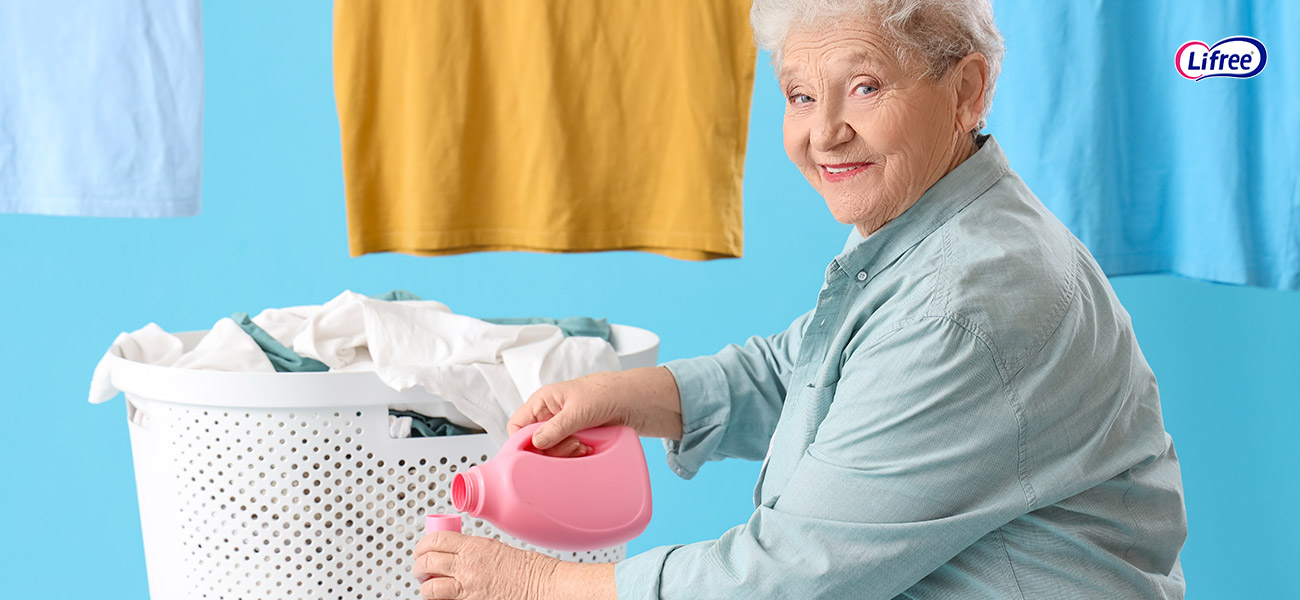Laundry Tips for Clothes and Bedding Affected by Grown-Up Diapers and Incontinence
So, here’s the thing nobody really likes to talk about — dealing with laundry when there’s incontinence involved, not like regular laundry. Whether it’s a loved one who uses adult diapers or caretakers managing it themself, the mess, the smell, the stains, and the stress of keeping things clean — it’s a lot.
People suffering through incontinence go through this. At first, most people make these mistakes. Tossing things straight into the machine, using hot water, mixed laundry loads. Spoiler alert: none of that helped. But over time, it was figured out how few tricks that make life easier can be incorporated in your routine.
Let’s share them with you — not as a pro, but as someone who’s been in the same spot, staring at soiled bedsheets wondering what to do next.
1. Act Fast — Don’t Let It Sit
If there’s been a leak, don’t leave the clothes or bedsheets in a pile for later. The longer the mess sits, the harder it is to clean — and the smell? It settles in deep. I kept a bucket in the bathroom with cold water and a few drops of detergent. Anything that got wet or stained went straight in for soaking.
2. Cold Water First, Always
This one’s big. Never start with hot water. It sets protein stains (yes, pee counts) and makes them worse. Always rinse or soak with cold water first. You can move to warm later, but never skip the cold rinse.
3. Use Enzyme-Based Detergents
Not all detergents are built the same. The regular stuff sometimes can’t handle body fluids. I switched to an enzyme-based one — something labeled for “bio stains” or even baby clothes — and it made a huge difference. The smell started coming out completely, and even the yellow patches faded.
4. Add Vinegar or Baking Soda (But Not Both)
If you’re dealing with persistent odor, a splash of white vinegar in the rinse cycle helps. If it’s stains that bother you, baking soda in the soak bucket works. But don’t mix them — they cancel each other out. Try at your own risk, foam everywhere, not fun to work after then. Avoid it please.
5. Separate Loads — No Mixing
I learned this the hard way. I used to throw everything together. Big mistake. Always wash clothes or sheets affected by diaper leaks separately from your regular laundry. It’s not just more hygienic — mentally, you’ll also feel better.
6. Double Rinse If Needed
Even after a full wash, sometimes there’s still a faint smell. Hit that extra rinse button. It uses more water, yeah, but better than sleeping on a bedsheet that smells slightly off, trust me.
7. Sunlight is Magic
If you can dry things outside — do it. The sun is nature’s best stain remover and deodorizer. Even in winter, just placing clothes where some sunlight hits helps a lot. People even call it “sun bleach” , probably a made-up name.
8. Mattress Hacks That Help
For bedding, layer up. You can start putting an old towel between the bedsheet and the waterproof sheet. That way, you don’t have to clean the big mattress protector every time. Just take the towel, toss it in the soak bucket, and that’s that.
9. Get a Dedicated Hamper or Bag
Keep a separate laundry hamper or wet bag just for diaper-related laundry. That way you’re not mixing stuff or losing time sorting. You can keep ours in the bathroom for quick access.
10. Don’t Be Too Hard on Yourself
Lastly, and maybe most importantly — don’t stress if some stains don’t go away completely. Clean doesn’t always mean spotless. If it’s fresh, smells fine, and you did your best — that’s more than enough.
It’s not the kind of chore anyone signs up for, but once you find your rhythm, it gets manageable. Initially it will be a bit awkward to do it.
If you’re dealing with this stuff — you’re doing something that requires patience, care, and love. That’s no small thing. Respect to you.
FAQ’s
2. Can I wash incontinence-affected items with other laundry?
It’s recommended to wash clothes and bedding affected by incontinence separately to maintain hygiene and prevent cross-contamination. Incontinence-related laundry contains bacteria and strong odors, which may transfer to other garments during washing. Use hot water (above 60°C or 140°F) and a disinfectant detergent to kill germs and break down any organic residue. Once cleaned and dried properly, these clothes can be stored and reused safely. You may add a second rinse cycle to ensure all detergent and odor are completely removed. Avoid washing them with delicate items or baby clothes. Always sanitize the washing machine with an empty hot cycle using bleach or white vinegar once the load is complete.
3. What type of detergent should I use for incontinence laundry?
For laundry affected by incontinence, use a heavy-duty, enzyme-based detergent that effectively breaks down organic matter like urine and fecal residue. Look for formulas specifically designed for odor and stain removal. If your regular detergent doesn’t handle the job well, consider adding a booster like baking soda, borax, or oxygen bleach for enhanced effectiveness. Avoid detergents with strong artificial fragrances, as they might mask odors without eliminating the source. Hypoallergenic options are also available if the user has sensitive skin. Remember to read label instructions and test the detergent on a small area if you’re dealing with delicate fabrics.
4. How can I get rid of lingering urine odor from bedding?
To remove lingering urine odor from bedding, start by soaking the fabric in a mixture of cold water and vinegar (1:3 ratio) for 30 minutes before washing. Then launder with hot water (if fabric allows) and an odor-fighting detergent. You can add baking soda to the wash cycle for extra deodorizing power. For persistent smells, use an oxygen-based bleach or enzymatic cleaner. Avoid using fabric softeners, as they can trap odors in the fibers. Always dry bedding in direct sunlight when possible, as the UV rays help kill bacteria and freshen fabrics naturally. Repeat the wash if the odor persists after drying.
5. How often should I wash clothes and bedding used by diaper users?
Clothes and bedding used by grown-up diaper users should ideally be washed daily or after each incident of soiling to maintain hygiene and comfort. Prolonged exposure to moisture and bacteria can lead to skin infections, rashes, and unpleasant odors. If daily washing isn’t possible, at least ensure that soiled items are rinsed immediately and stored separately in a sealed laundry bag or bin until they can be washed. Bedsheets, mattress covers, and underpads should also be washed regularly—twice a week or more if there are frequent leaks. Timely laundering not only improves sanitation but also helps prolong fabric life.
6. Is machine washing safe for incontinence-affected fabrics?
Yes, machine washing is generally safe for clothes and bedding affected by incontinence, provided you follow the right steps. Use a pre-rinse or soak cycle with cold water, followed by a hot wash with a strong detergent. Set the washing machine to a longer cycle for a thorough clean. For extra sanitation, add baking soda or disinfectant. Be cautious with delicate fabrics and check care labels to avoid shrinking or damage. After the load, consider running an empty hot cycle with bleach or vinegar to clean the washing machine drum and remove any lingering bacteria or odor from the previous load.
7. Can fabric softeners be used on clothes affected by adult diapers?
It's best to avoid fabric softeners when washing clothes affected by incontinence or grown-up diapers. Fabric softeners leave a coating on fabrics that may trap odors and reduce absorbency, especially on reusable pads or mattress protectors. Instead, opt for white vinegar during the rinse cycle for natural softening and deodorizing benefits. Vinegar helps break down residues left by urine or detergent while softening fabric naturally. If you prefer a scent, use a few drops of essential oil mixed with vinegar. Also, consider using dryer balls in the tumble dryer—they soften fabrics without chemicals.
8. How should I dry clothes and bedding after washing?
After washing incontinence-affected laundry, it’s important to dry the items thoroughly to prevent mildew or bacteria growth. Tumble drying on a medium to high setting is effective, especially if the fabric label permits it. For added sanitation, sunlight drying is ideal—UV rays naturally kill germs and neutralize odors. Ensure items are fully dry before storing them to avoid musty smells or contamination. Avoid over-drying delicate fabrics that may shrink. Using dryer balls can help reduce static and speed up drying time. If indoor drying is your only option, use a well-ventilated space and a fan or dehumidifier.
9. What precautions should I take while handling soiled laundry?
Handling soiled laundry from adult diaper users requires hygiene precautions. Wear disposable gloves when touching or rinsing soiled clothes and bedding. Use a separate bin or sealed bag to store used items until they’re washed. Avoid shaking clothes to prevent spreading germs. Rinse solid waste off before placing laundry in the machine. Wash your hands thoroughly after handling, and regularly disinfect the laundry basket. Clean your washing machine weekly, especially after heavy-duty loads. These steps protect you and others from bacteria exposure and maintain household cleanliness. Always wash soiled laundry promptly to prevent staining and odor buildup.
10. How do I store incontinence-washed laundry hygienically?
After laundering, store incontinence-washed clothes and bedding in a clean, dry area. Use designated drawers or storage bins with lids to protect from dust and humidity. Ensure the items are completely dry before folding and storing to avoid mold or mildew. You can also use breathable cotton storage bags or fabric organizers to allow airflow and keep them fresh. Avoid plastic bags or tightly sealed containers without ventilation. Label storage for easy identification and to separate incontinence garments from regular laundry. For extra freshness, place odor-absorbing sachets or baking soda packets in storage drawers.






















